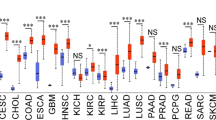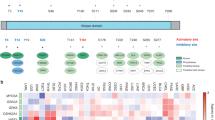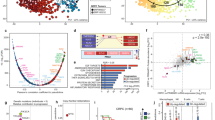Abstract
The role of cyclin-dependent kinase 2 (CDK2) in cancer is controversial. A major hurdle is the availability of tools to easily assess its activity across many samples. Here, we introduce a transcriptional signature to specifically track CDK2 activity. It responds to genetic and chemical perturbations in the CDK-RB-E2F axis, correlates with mitotic rate in vitro and in vivo and reacts rapidly to changes in CDK2 activity during cell cycle progression. We find that CDK2 activity is specifically elevated in human testes, mirroring its critical function in mice, and report very distinct profiles across human cancers. Increased CDK2 activity decreases risk in colon cancer, but elevates poor outcome two- to fivefold in specific tumors, including low grade glioma, kidney, thyroid, adrenocortical and prostate cancer. These are typically ‘CDK2-low’ cancers, suggesting that above a certain threshold CDK2 promotes progression, but further increases do not influence outcome. Multivariate analysis revealed that the CDK2 signature is the most important predictive feature in these cancers versus dozens of other clinical parameters, such as tumor grade or mitotic index. Thus, transcriptome data provides a novel, straightforward method to monitor CDK2 activity, implicates key roles for the kinase in a subset of human tissues and tumors and enhances cancer risk prediction. The strategy used here for CDK2 could be applied to other kinases that influence transcription.
This is a preview of subscription content, access via your institution
Access options
Subscribe to this journal
Receive 50 print issues and online access
$259.00 per year
only $5.18 per issue
Buy this article
- Purchase on Springer Link
- Instant access to full article PDF
Prices may be subject to local taxes which are calculated during checkout








Similar content being viewed by others
References
Lim S, Kaldis P . Cdks, cyclins and CKIs: roles beyond cell cycle regulation. Dev Camb Engl 2013; 140: 3079–3093.
Malumbres M, Harlow E, Hunt T, Hunter T, Lahti JM, Manning G et al. Cyclin-dependent kinases: a family portrait. Nat Cell Biol 2009; 11: 1275–1276.
Burkhart DL, Sage J . Cellular mechanisms of tumour suppression by the retinoblastoma gene. Nat Rev Cancer 2008; 8: 671–682.
Palancade B, Bensaude O . Investigating RNA polymerase II carboxyl-terminal domain (CTD) phosphorylation. Eur J Biochem 2003; 270: 3859–3870.
Firestein R, Bass AJ, Kim SY, Dunn IF, Silver SJ, Guney I et al. CDK8 is a colorectal cancer oncogene that regulates beta-catenin activity. Nature 2008; 455: 547–551.
Morris EJ, Ji J-Y, Yang F, Di Stefano L, Herr A, Moon N-S et al. E2F1 represses β-catenin transcription and is antagonized by both pRB and CDK8. Nature 2008; 455: 552–556.
Deng L, Ammosova T, Pumfery A, Kashanchi F, Nekhai S . HIV-1 Tat Interaction with RNA polymerase II C-terminal domain (CTD) and a dynamic association with CDK2 induce CTD phosphorylation and transcription from HIV-1 promoter. J Biol Chem 2002; 277: 33922–33929.
Nekhai S, Zhou M, Fernandez A, Lane WS, Lamb NJC, Brady J et al. HIV-1 Tat-associated RNA polymerase C-terminal domain kinase, CDK2, phosphorylates CDK7 and stimulates Tat-mediated transcription. Biochem J 2002; 364: 649.
Chi Y, Welcker M, Hizli AA, Posakony JJ, Aebersold R, Clurman BE . Identification of CDK2 substrates in human cell lysates. Genome Biol 2008; 9: R149.
Asghar U, Witkiewicz AK, Turner NC, Knudsen ES . The history and future of targeting cyclin-dependent kinases in cancer therapy. Nat Rev Drug Discov 2015; 14: 130–146.
Malumbres M, Barbacid M . Cell cycle, CDKs and cancer: a changing paradigm. Nat Rev Cancer 2009; 9: 153–166.
Welcker M, Singer J, Loeb KR, Grim J, Bloecher A, Gurien-West M et al. Multisite phosphorylation by Cdk2 and GSK3 controls cyclin E degradation. Mol Cell 2003; 12: 381–392.
Zhang W, Koepp DM . Fbw7 isoform interaction contributes to cyclin E proteolysis. Mol Cancer Res MCR 2006; 4: 935–943.
Ishihara H, Yoshida T, Kawasaki Y, Kobayashi H, Yamasaki M, Nakayama S et al. A new cancer diagnostic system based on a CDK profiling technology. Biochim Biophys Acta Mol Basis Dis 2005; 1741: 226–233.
Spencer SL, Cappell SD, Tsai F-C, Overton KW, Wang CL, Meyer T . The proliferation-quiescence decision is controlled by a bifurcation in CDK2 activity at mitotic exit. Cell 2013; 155: 369–383.
Akli S, Pelt CSV, Bui T, Meijer L, Keyomarsi K . Cdk2 is required for breast cancer mediated by the low-molecular-weight isoform of cyclin E. Cancer Res 2011; 71: 3377–3386.
Campaner S, Doni M, Hydbring P, Verrecchia A, Bianchi L, Sardella D et al. Cdk2 suppresses cellular senescence induced by the c-myc oncogene. Nat Cell Biol 2010; 12: 54–59.
Gillam MP, Nimbalkar D, Sun L, Christov K, Ray D, Kaldis P et al. MEN1 tumorigenesis in the pituitary and pancreatic islet requires Cdk4 but not Cdk2. Oncogene 2014; 124: 1056–1061.
Macias E, Kim Y, Marval PLM de, Klein-Szanto A, Rodriguez-Puebla ML . Cdk2 deficiency decreases ras/CDK4-dependent malignant progression, but not myc-induced tumorigenesis. Cancer Res 2007; 67: 9713–9720.
Martín A, Odajima J, Hunt SL, Dubus P, Ortega S, Malumbres M et al. Cdk2 is dispensable for cell cycle inhibition and tumor suppression mediated by p27Kip1 and p21Cip1. Cancer Cell 2005; 7: 591–598.
Padmakumar VC, Aleem E, Berthet C, Hilton MB, Kaldis P . Cdk2 and Cdk4 activities are dispensable for tumorigenesis caused by the loss of p53. Mol Cell Biol 2009; 29: 2582–2593.
Puyol M, Martín A, Dubus P, Mulero F, Pizcueta P, Khan G et al. A synthetic lethal interaction between K-Ras oncogenes and Cdk4 unveils a therapeutic strategy for non-small cell lung carcinoma. Cancer Cell 2010; 18: 63–73.
Ray D, Terao Y, Christov K, Kaldis P, Kiyokawa H . Cdk2-null mice are resistant to ErbB-2-induced mammary tumorigenesis. Neoplasia 2011; 13: 439–444.
Hongo F, Takaha N, Oishi M, Ueda T, Nakamura T, Naitoh Y et al. CDK1 and CDK2 activity is a strong predictor of renal cell carcinoma recurrence. Urol Oncol 2014; 32: 1240–1246.
Kim SJ, Nakayama S, Miyoshi Y, Taguchi T, Tamaki Y, Matsushima T et al. Determination of the specific activity of CDK1 and CDK2 as a novel prognostic indicator for early breast cancer. Ann Oncol 2008; 19: 68–72.
Kim SJ, Nakayama S, Shimazu K, Tamaki Y, Akazawa K, Tsukamoto F et al. Recurrence risk score based on the specific activity of CDK1 and CDK2 predicts response to neoadjuvant paclitaxel followed by 5-fluorouracil, epirubicin and cyclophosphamide in breast cancers. Ann Oncol Off J Eur Soc Med Oncol 2012; 23: 891–897.
Kubo H, Suzuki T, Matsushima T, Ishihara H, Uchino K, Suzuki S et al. Cyclin-dependent kinase-specific activity predicts the prognosis of stage I and stage II non-small cell lung cancer. BMC Cancer 2014; 14: 755.
Sangwan M, McCurdy SR, Livne-bar I, Ahmad M, Wrana JL, Chen D et al. Established and new mouse models reveal E2f1 and Cdk2 dependency of retinoblastoma, and expose effective strategies to block tumor initiation. Oncogene 2012; 31: 5019–5028.
Sakaue-Sawano A, Kurokawa H, Morimura T, Hanyu A, Hama H, Osawa H et al. Visualizing spatiotemporal dynamics of multicellular cell-cycle progression. Cell 2008; 132: 487–498.
Wang L, Hurley DG, Watkins W, Araki H, Tamada Y, Muthukaruppan A et al. Cell cycle gene networks are associated with melanoma prognosis. PLoS One 2012; 7: e34247.
Molenaar JJ, Ebus ME, Geerts D, Koster J, Lamers F, Valentijn LJ et al. Inactivation of CDK2 is synthetically lethal to MYCN over-expressing cancer cells. Proc Natl Acad Sci 2009; 106: 12968–12973.
Garnett MJ, Edelman EJ, Heidorn SJ, Greenman CD, Dastur A, Lau KW et al. Systematic identification of genomic markers of drug sensitivity in cancer cells. Nature 2012; 483: 570–575.
Cline MS, Craft B, Swatloski T, Goldman M, Ma S, Haussler D et al. Exploring TCGA Pan-Cancer Data at the UCSC Cancer Genomics Browser. Sci Rep 2013; 3: 2652.
Kronja I, Orr-Weaver TL . Translational regulation of the cell cycle: when, where, how and why? Philos Trans R Soc Lond B Biol Sci 2011; 366: 3638–3652.
Bracken AP, Ciro M, Cocito A, Helin K . E2F target genes: unraveling the biology. Trends Biochem Sci 2004; 29: 409–417.
Berkofsky-Fessler W, Nguyen TQ, Delmar P, Molnos J, Kanwal C, DePinto W et al. Preclinical biomarkers for a cyclin-dependent kinase inhibitor translate to candidate pharmacodynamic biomarkers in phase I patients. Mol Cancer Ther 2009; 8: 2517–2525.
Whitfield ML, Sherlock G, Saldanha AJ, Murray JI, Ball CA, Alexander KE et al. Identification of genes periodically expressed in the human cell cycle and their expression in tumors. Mol Biol Cell 2002; 13: 1977–2000.
Aleem E, Kiyokawa H, Kaldis P . Cdc2–cyclin E complexes regulate the G1/S phase transition. Nat Cell Biol 2005; 7: 831–836.
Satyanarayana A, Kaldis P . Mammalian cell-cycle regulation: several Cdks, numerous cyclins and diverse compensatory mechanisms. Oncogene 2009; 28: 2925–2939.
Adler AS, McCleland ML, Truong T, Lau S, Modrusan Z, Soukup TM et al. CDK8 maintains tumor dedifferentiation and embryonic stem cell pluripotency. Cancer Res 2012; 72: 2129–2139.
Galbraith MD, Allen MA, Bensard CL, Wang X, Schwinn MK, Qin B et al. HIF1A employs CDK8-mediator to stimulate RNAPII elongation in response to hypoxia. Cell 2013; 153: 1327–1339.
Tsutsui T, Fukasawa R, Tanaka A, Hirose Y, Okhuma Y . Identification of target genes for the CDK subunits of the Mediator complex. Genes Cells Devoted Mol Cell Mech 2011; 16: 1208–1218.
Anastassiadis T, Deacon SW, Devarajan K, Ma H, Peterson JR . Comprehensive assay of kinase catalytic activity reveals features of kinase inhibitor selectivity. Nat Biotechnol 2011; 29: 1039–1045.
Chen S, Bohrer LR, Rai AN, Pan Y, Gan L, Zhou X et al. Cyclin-dependent kinases regulate epigenetic gene silencing through phosphorylation of EZH2. Nat Cell Biol 2010; 12: 1108–1114.
Lee JK, Havaleshko DM, Cho H, Weinstein JN, Kaldjian EP, Karpovich J et al. A strategy for predicting the chemosensitivity of human cancers and its application to drug discovery. Proc Natl Acad Sci USA 2007; 104: 13086–13091.
Stojadinovic A, Ghossein RA, Hoos A, Nissan A, Marshall D, Dudas M et al. Adrenocortical carcinoma: clinical, morphologic, and molecular characterization. J Clin Oncol Off J Am Soc Clin Oncol 2002; 20: 941–950.
Stojadinovic A, Brennan MF, Hoos A, Omeroglu A, Leung DHY, Dudas ME et al. Adrenocortical adenoma and carcinoma: histopathological and molecular comparative analysis. Mod Pathol 2003; 16: 742–751.
Weiss LM . Comparative histologic study of 43 metastasizing and nonmetastasizing adrenocortical tumors. Am J Surg Pathol 1984; 8: 163–169.
Weiss LM, Medeiros LJ, Vickery AL . Pathologic features of prognostic significance in adrenocortical carcinoma. Am J Surg Pathol 1989; 13: 202–206.
Heaton JH, Wood MA, Kim AC, Lima LO, Barlaskar FM, Almeida MQ et al. Progression to adrenocortical tumorigenesis in mice and humans through insulin-like growth factor 2 and β-catenin. Am J Pathol 2012; 181: 1017–1033.
Assié G, Letouzé E, Fassnacht M, Jouinot A, Luscap W, Barreau O et al. Integrated genomic characterization of adrenocortical carcinoma. Nat Genet 2014; 46: 607–612.
GTEx Consortium. The genotype-tissue expression (GTEx) project. Nat Genet 2013; 45: 580–585.
Berthet C, Aleem E, Coppola V, Tessarollo L, Kaldis P . Cdk2 knockout mice are viable. Curr Biol 2003; 13: 1775–1785.
Ortega S, Prieto I, Odajima J, Martín A, Dubus P, Sotillo R et al. Cyclin-dependent kinase 2 is essential for meiosis but not for mitotic cell division in mice. Nat Genet 2003; 35: 25–31.
Li J-Q, Miki H, Ohmori M, Wu F, Funamoto Y . Expression of cyclin E and cyclin-dependent kinase 2 correlates with metastasis and prognosis in colorectal carcinoma. Hum Pathol 2001; 32: 945–953.
Breiman L . Random forests. Mach Learn 2001; 45: 5–32.
Irizarry RA, Hobbs B, Collin F, Beazer-Barclay YD, Antonellis KJ, Scherf U et al. Exploration, normalization, and summaries of high density oligonucleotide array probe level data. Biostat Oxf Engl 2003; 4: 249–264.
Zhu J, Sanborn JZ, Benz S, Szeto C, Hsu F, Kuhn RM et al. The UCSC Cancer Genomics Browser. Nat Methods 2009; 6: 239–240.
Gao J, Aksoy BA, Dogrusoz U, Dresdner G, Gross B, Sumer SO et al. Integrative analysis of complex cancer genomics and clinical profiles using the cBioPortal. Sci Signal 2013; 6: pl1–pl1.
Acknowledgements
We thank G Bader, F Roth and J Wrana for helpful comments. This project was funded by grants to RB from the Canadian Institutes for Health Research (CIHR), Foundation Fighting Blindness Canada, Krembil Foundation, Ontario Institute for Cancer Research through funding provided by the Government of Ontario and the Terry Fox Research Institute. SRM was supported by scholarships from Peterborough KM Hunter Foundation, CIHR (Vanier Graduate Scholarship) and the CIHR Biological Therapeutics Program.
Author contributions
SRM and RB designed the experiments and drafted the manuscript. MP and MA gathered samples and performed microarray on retinal samples. The data analysis was performed by SRM. SRM and RB discussed and revised the manuscript. All authors read and approved the final manuscript.
Author information
Authors and Affiliations
Corresponding author
Ethics declarations
Competing interests
The authors declare no conflict of interest.
Additional information
Supplementary Information accompanies this paper on the Oncogene website
Rights and permissions
About this article
Cite this article
McCurdy, S., Pacal, M., Ahmad, M. et al. A CDK2 activity signature predicts outcome in CDK2-low cancers. Oncogene 36, 2491–2502 (2017). https://doi.org/10.1038/onc.2016.409
Received:
Revised:
Accepted:
Published:
Issue Date:
DOI: https://doi.org/10.1038/onc.2016.409
This article is cited by
-
LINC00955 suppresses colorectal cancer growth by acting as a molecular scaffold of TRIM25 and Sp1 to Inhibit DNMT3B-mediated methylation of the PHIP promoter
BMC Cancer (2023)
-
Discovery of small molecule degraders for modulating cell cycle
Frontiers of Medicine (2023)
-
The Oncogenic Role of Cyclin-Dependent Kinase Inhibitor 2C in Lower-Grade Glioma
Journal of Molecular Neuroscience (2023)
-
Wilms’ tumor 1-associating protein promotes renal cell carcinoma proliferation by regulating CDK2 mRNA stability
Journal of Experimental & Clinical Cancer Research (2018)
-
Rb is required for retinal angiogenesis and lamination
Cell Death & Disease (2018)



